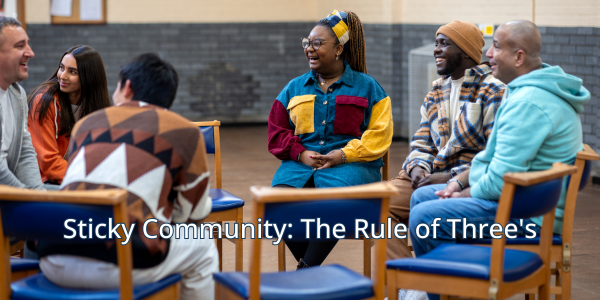by Rick Chromey
In Millennial dating culture, there’s a popular acronym known as “DTR” or “defining the relationship.” It’s the first step in going steady. A DTR solidifies commitment and Facebook status (moving a person from “single” to “in a relationship”). Later DTRs produce “engaged,” “married,” “it’s complicated,” “separated,” or “divorced” status updates.
As humans, we’re constantly DTR-ing.
Even at church.
The process of attracting, engaging, assimilating, and equipping a fully devoted follower of Christ and church leader involves continual DTR-ing.
As people journey through this process, there are multiple, critical points to make a decision.
I call these points the “Rule of Threes” and they’re essential to creating a “sticky” community.
Three Minutes: Visitor
It takes three minutes for visitors to decide whether they like your church. More to the point, they want to know if you like them. It’s a DTR. Consequently, it’s important to be friendly but not obnoxious. It’s vital to provide relevant information about next steps. Where do I go? What do I do? Never assume visitors will figure it out. What first-timers need is security mixed with a smile. They don’t want to feel embarrassed, shamed, or lost. And many do.
Three Visits: Guest
It takes three visits for a guest to decide to commit to regular attendance. That’s another DTR moment. If guests feel wanted and enjoy the experience, they’ll commit, but if they sense struggle, conflict, or discord, they’ll bolt. Or they may decide it’s not a good fit and leave for doctrinal reasons or due to personal preference, and that’s okay. In any case, for guests to stay, it must be easy for them to learn basic truths about your church culture, feel comfortable with your traditions, and sense a potential for friendship.
Three Months: Member
It takes three months of regular attendance (three out of four Sundays) for people to commit as members. Unfortunately, many church attenders today are more guests than members. Their sporadic attendance, even if they call a particular church their home, is largely a loose commitment. It’s common for irregular guest attenders to know very few people in their church.
Church members are like members of a physical body. They’re part of a system. They’re known by others and, conversely, they know those around them.
Friendships are the key to moving guests into membership and small groups. We all hunger to be known, and the faster, better, and richer people experience relationship, the sooner commitment to the community happens. Unfortunately, in many churches today, few people are true members. Most are perennial guests, and consequently, attendance fluctuates and turnover is high.
Three Years: Leader
It takes three years for committed members to know whether they’ll stay or move on. On average, younger families move every three years to new communities for new work. However, regardless of age or circumstance, in three years of church attendance, if members don’t sense empowerment, feel they matter, or have significant relationships, they’ll drop out and move on.
Essentially, it takes three years to grow a leader. It’s nothing new. That’s how long it took Jesus. The difference was, his leaders changed the world. A lot of ours just change addresses.
The Rule of Threes teaches us to be intentionally “sticky” at all phases of assimilation. It’s not enough to be initially attractive if we can’t keep visitors or guests. And what does it profit to produce members but no leaders? Stickiness happens when churches create environments that are secure and pleasurable, empowering and affirming, focused upon community, and baptized in grace.
And sticky community is driven less by insightful sermons, dynamic worship, or clever slogans and more by transparent, authentic friendships.
It’s about DTR.
Dynamic. Transforming. Relationships.
And everyone wants them.


